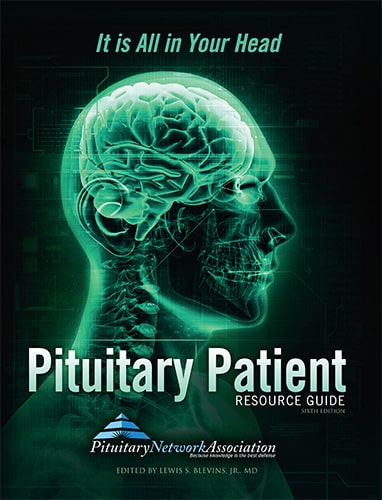Pituitary Glossary starting with C
Clinical
That which can be observed in patients. Research that uses patients to test new treatments, as opposed to laboratory testing or research in animals.
Clinical research is research that either directly involves a particular person or group of people or uses materials from humans, such as their behavior or samples of their tissue, that can be linked to a particular living person. (The process of clinical research, however, protects personal data.)
Clinical Cooperative Group
A group of academic institutions and treatment centers cooperating to perform clinical research and clinical trials.
The Clinical Trials Cooperative Group Program brings researchers, cancer centers, and doctors together into cooperative groups. These groups work with the NCI (National Cancer Institute) to identify important questions in cancer research, and design and conduct multisite clinical trials to answer these questions.
CNS
Central Nervous System.
The central nervous system (CNS) is made up of the spinal cord and brain. The brain receives nerve impulses from the spinal cord and cranial nerves. The spinal cord contains the nerves that carry messages between the body and the brain. Spinal cord injury occurs when there is damage to the cells within the spinal cord or the nerves of the spinal cord are severed.
CO
Childhood onset: adult patients with growth hormone deficiency from childhood.
Childhood onset as in adult patients with growth hormone deficiency occurring in childhood. Also referring to childhood onset diseases such as type 1 diabetes.
Colonoscope
An instrument which allows visualization of the inside of the colon.
A thin, tube-like instrument used to examine the inside of the colon. A colonoscope has a light and a lens for viewing and may have a tool to remove tissue.
Colonoscopy
Procedure to examine the colon and rectal tissues by means of an instrument known as a colonoscope.
Visual examination of the inner surface of the colon by means of an instrument for the examination of the interior of the colon — the division of the large intestine extending from the first part of the large intestine to the rectum.
Congenital
Existing before or at birth.
Consisting at or dating from birth. Acquired during development in the uterus and not through heredity.
Congenital Adrenal Hyperplasia
21-hydroxylase deficiency (also known as congenital adrenal hyperplasia)
An inherited disorder that affects the adrenal glands. These glands are located on top of the kidneys and produce a variety of hormones that regulate many essential functions in the body. Two of these hormones, cortisol and aldosterone, are produced from cholesterol through the activity of an enzyme called 21-hydroxylase. Cortisol has numerous functions such as maintaining blood sugar levels, protecting the body from stress, and suppressing inflammation. Aldosterone, sometimes called the salt-retaining hormone, acts on the kidneys to regulate the levels of salt and water in the body, which affects blood pressure. People with 21-hydroxylase deficiency have a shortage of the 21-hydroxylase enzyme, which impairs the conversion of cholesterol to cortisol and aldosterone. When the precursors of cortisol and aldosterone build up in the adrenal glands, they are converted to male sex hormones called androgens. Androgens are normally responsible for the appearance of secondary sex characteristics in males (virilization). Elevated levels of androgens can affect the growth and development of both males and females.
Contrast Agent, Contrast Medium
Substances used in radiography that allow visualization of certain tissues.
Any internally administered substance that has a different opacity from soft tissue on radiography or computed tomography; includes barium, used to make opaque parts of the gastrointestinal tract; water-soluble iodinated compounds, used to make opaque blood vessels or the genitourinary tract; may refer to air occurring naturally or introduced into the body; also, paramagnetic substances used in magnetic resonance imaging.
Cranial Cavity
The skull.
The crainial cavity is the boney structure that contains the brain; the largest portion of the central nervous system.
Craniectomy
Surgery performed on the skull where pieces of bone are removed to gain access to the brain, and the bone pieces are not replaced.
See craniotomy.
Craniopharyngioma
Craniopharyngiomas are intracranial tumors that are typically both cystic and solid in structure. They occur most commonly in childhood and adolescence and in later adult life after age 50 years. They account for 2-4% of primary brain tumors.
Craniopharyngiomas are usually not discovered until they press on important structures around them, and are frequently quite large (over 3 cm) when detected. They are histologically benign (not malignant) tumors, but they have a tendency to become adherent to structures in and around the pituitary gland and pituitary stalk, including the optic nerves, optic chiasm, intracranial arteries and the brain itself. They are thought to arise from remnants of the craniopharyngeal duct or Rathkes pouch which are developmental structures related to the primitive gut. Embryonic cells from an incompletely involuted craniopharyngeal duct or anterior pituitary gland may give rise to a craniopharyngioma. These tumors are closely related to another cystic masses occasionally seen in the pituitary called Rathkes cleft cyst.
Symptoms
The symptoms produced by a craniopharyngioma vary depending upon the tumors location. If it compresses the pituitary stalk or involves the area of the pituitary gland itself, the tumor can cause partial or complete pituitary hormone deficiency. This frequently results in one or more of the following: growth failure, delayed puberty, loss of normal menstrual function or sexual desire, increased sensitivity to cold, fatigue, constipation, dry skin, nausea, low blood pressure, and depression.
Pituitary stalk compression can also cause diabetes insipidus and may increase prolactin levels causing a milky discharge from the breast (galactorrhea). If the craniopharyngioma involves the optic tracts, chiasm, or nerves, then visual disturbances can result. Involvement of the hypothalamus, an area at the base of the brain, may result in obesity, increased drowsiness, temperature regulation abnormalities, and diabetes insipidus (DI). Other common symptoms include personality changes, headache, confusion, and vomiting.
Diagnosis
The best means of visualizing a craniopharyngioma is with a MRI or CT scan of the pituitary region performed without and with contrast.
Treatment
The initial treatment for a craniopharyngioma is usually surgery. The goal of surgery is to completely remove the tumor while improving or at least preserving pituitary, visual and brain function. Depending upon the location of the tumor, several approaches may be utilized. If the tumor is predominantly above the pituitary fossa (suprasellar), a craniotomy is generally required for optimal exposure and tumor removal. In a minority of patients, the tumor is relatively small (less than 3 cm) and located primarily in the area of the pituitary gland (intrasellar). In such patients, a transsphenoidal route can be used. When the tumor cannot be completely removed, radiation treatment generally offers some degree of tumor control and prolonged survival. Both conventional (external beam) and stereotactic radiosurgery are effective in controlling growth of craniopharyngiomas, but stereotactic radiation delivers a higher radiation dose to the tumor more safely. Consequently it is the preferred radiation technique. Because hormone deficiencies can develop due to the tumor mass effect or many years after radiation treatment, all individuals treated with radiation should have periodic evaluations by an endocrinologist throughout their lifetimes. Additionally, because of the tendency for craniopharyngiomas to recur, repeat MRIs or CT scans should be obtained at least once a year for the first several years after surgery or radiation therapy.
CRH
Corticotropin releasing hormone.
Produced by the hypothalamus and stimulates ACTH release by the pituitary gland.
Crohn’s Disease (Also Known As Regional Enteritis
A moderately severe chronic inflammation of the intestine, especially of the small intestine, of unknown cause, involving the obstruction of the lower part of the small bowel and less frequently other parts of the gastrointestinal tract. It is characterized by patchy deep ulcers that may cause abnormal passages within the bowel, and narrowing and thickening of the bowel. Symptoms include fever, diarrhea, cramping abdominal pain, and weight loss.
Crohn’s disease usually involves the small intestine, most often the lower part (the ileum). In some cases, both the small and large intestine (colon or bowel) are affected. In other cases, only the colon is involved. Sometimes, inflammation also may affect the mouth, esophagus, stomach, duodenum, appendix, or anus. Crohn’s disease is a chronic condition and may recur at various times over a lifetime.
CSF
Cerebrospinal fluid.
See Cerebrospinal fluid.









